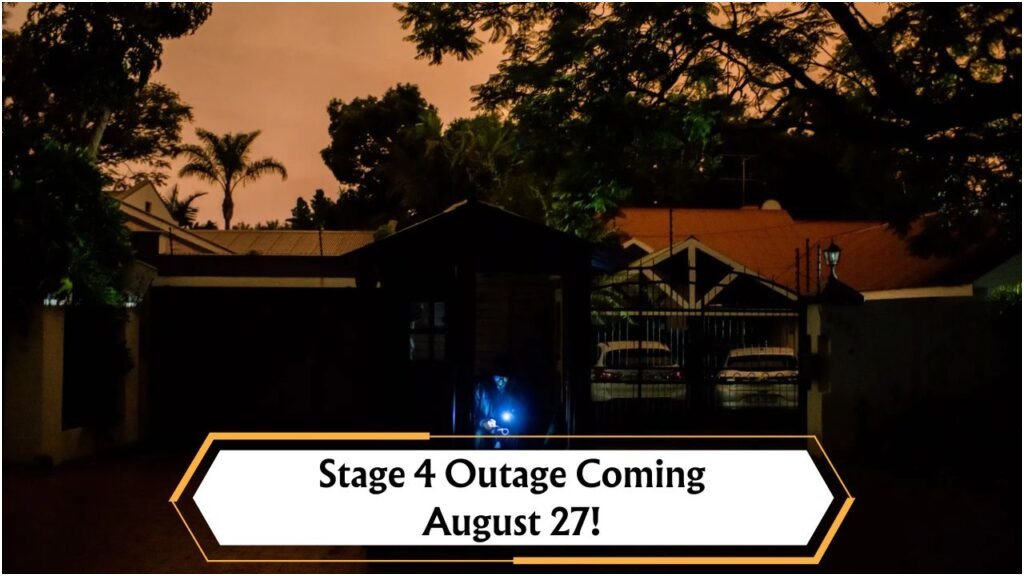Stage 4 Load Shedding Hits Again on August 27, 2025: South Africans brace themselves as Stage 4 load shedding reemerges, casting a shadow over daily activities and igniting conversations about energy solutions. On August 27, 2025, this power crisis affects numerous suburbs, leaving residents to grapple with the inconvenience of scheduled outages. With the country’s energy grid under strain, understanding the affected areas and the impact on daily life becomes crucial. Residents are urged to stay informed and prepared as the nation navigates this recurring challenge.
Suburbs Affected by Stage 4 Load Shedding on August 27, 2025
As Eskom implements Stage 4 load shedding, several suburbs across South Africa will experience power outages. This scheduled interruption is part of the utility’s effort to balance the national grid and reduce the risk of a complete blackout. The following areas are set to be affected:
- Sandton
- Pretoria East
- Durban North
- Cape Town CBD
- Port Elizabeth Central
- Bloemfontein West
- Mbombela
Understanding the Load Shedding Schedule
Load shedding schedules can be complex, and understanding them is key to minimizing disruption. Eskom releases these schedules to inform the public of planned outages, typically based on the stages of load shedding activated. Stage 4 load shedding means that up to 4,000 MW needs to be shed, affecting various areas in a rotational manner throughout the day. Residents can access these schedules via Eskom’s website or app for real-time updates. It’s advisable to regularly check these platforms to stay informed and plan accordingly.
| Stage | MW Shed |
|---|---|
| Stage 1 | 1,000 MW |
| Stage 2 | 2,000 MW |
| Stage 3 | 3,000 MW |
| Stage 4 | 4,000 MW |
| Stage 5 | 5,000 MW |
| Stage 6 | 6,000 MW |
| Stage 7 | 7,000 MW |
| Stage 8 | 8,000 MW |
Impact of Load Shedding on Daily Life in South Africa
The effects of Stage 4 load shedding extend beyond mere inconvenience. Businesses face operational challenges, particularly those reliant on continuous power supply. Homeowners, too, must adjust their routines, often resorting to backup solutions like generators or inverters. The economic impact is notable, with productivity losses and increased operational costs. Residents are encouraged to adopt energy-saving measures to mitigate these effects, such as unplugging non-essential appliances and using energy-efficient lighting. Here are some practical tips to navigate these power outages:
 SASSA Child Grant: R560 Payments Set for August 22, 2025 – Ensure Your Bank Details Are Up-to-Date!
SASSA Child Grant: R560 Payments Set for August 22, 2025 – Ensure Your Bank Details Are Up-to-Date!
- Invest in rechargeable lights and batteries.
- Keep electronic devices charged before scheduled outages.
- Use gas stoves for cooking during power cuts.
- Plan your day around the load shedding schedule.
- Consider solar-powered solutions for long-term energy resilience.
Preparing for Future Load Shedding
| Action | Benefit |
|---|---|
| Install Solar Panels | Reduces reliance on the grid |
| Use Battery Storage | Provides backup during outages |
| Energy Audits | Identifies energy-saving opportunities |
| Smart Meters | Monitors consumption in real-time |
| Community Initiatives | Promotes shared energy solutions |
| Government Incentives | Supports renewable energy adoption |
| Load Management | Optimizes energy use during peak times |
Community Responses to Load Shedding Challenges
Communities across the nation are banding together to combat the challenges posed by load shedding. Neighbourhood watch groups are evolving into support networks, where residents share resources such as generators and offer assistance to vulnerable members. Online platforms and apps have become vital tools, providing real-time updates on load shedding schedules and fostering community engagement. Moreover, local businesses are adapting by adjusting their hours of operation and investing in renewable energy solutions. These collective efforts highlight the resilience and ingenuity of South Africans in the face of adversity.
- Community solar projects
- Shared generator initiatives
- Information-sharing platforms
- Local business collaborations
- Public awareness campaigns
- Energy conservation workshops
- Emergency response planning
The Role of Government in Addressing Load Shedding
Government intervention plays a critical role in alleviating the impact of load shedding. Policies aimed at boosting energy production and diversifying energy sources are essential for long-term stability. Initiatives such as the Integrated Resource Plan (IRP) outline strategies for increasing renewable energy capacity and reducing reliance on coal. Furthermore, government incentives for solar and wind energy adoption are encouraging both businesses and households to invest in sustainable solutions. By promoting a collaborative approach between public and private sectors, the government aims to create a more resilient energy infrastructure that can better withstand future challenges.
- Integrated Resource Plan (IRP)
- Renewable energy incentives
- Public-private partnerships
- Energy efficiency programs
Long-Term Solutions to South Africa’s Energy Crisis
Addressing South Africa’s energy crisis requires a multifaceted approach. Investment in renewable energy is paramount, with solar and wind power offering sustainable alternatives to fossil fuels. Energy storage technology, such as batteries, can provide critical backup during outages and help stabilize the grid. Additionally, improving grid infrastructure and implementing smart technologies can enhance efficiency and reliability. Collaborative efforts between government, industry, and communities are essential to drive innovation and secure South Africa’s energy future. By embracing these solutions, the nation can move towards a more sustainable and reliable energy landscape, reducing the frequency and severity of load shedding events.
- Investment in renewable energy sources
- Development of energy storage solutions
- Grid modernization
- Smart technology implementation
- Collaboration across sectors
Understanding the Cost of Load Shedding
 NSFAS R5,200 Allowance Deposits Begin September 8, 2025 – Ensure Your Bank Details Are Correct
NSFAS R5,200 Allowance Deposits Begin September 8, 2025 – Ensure Your Bank Details Are Correct
- Economic impact on businesses
- Increased operational costs
- Productivity losses
- Household inconvenience
Adapting to a Future with Load Shedding
As South Africa navigates the realities of recurring load shedding, adaptation becomes a necessity. Households and businesses alike are rethinking their energy consumption habits and exploring innovative solutions to mitigate the impact of power cuts. Embracing a culture of conservation and energy efficiency is key, as is investing in alternative energy sources and backup power systems. By fostering a proactive approach, South Africans can build resilience against future energy challenges, ensuring a brighter and more stable future.




